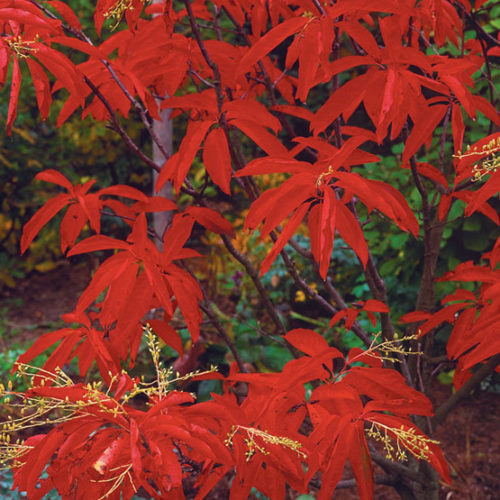Sourwood Tree A Legacy of Beauty
The Oxydendrum arboreum, also known as the Sourwood Tree, has been admired for its beautiful appearance and exceptional survival abilities. The origins of this species trace back to the southeastern United States and its existence has been documented in botanical records for several centuries. Indigenous communities and early settlers held Oxydendrum arboreum in high regard because of its functional benefits and dramatic seasonal changes. In the 18th century European explorers recorded their first observations of the tree while expressing awe at its vibrant fall colors and sophisticated summer flowers. This tree's existence within historical landscapes demonstrates its lasting importance across both wild and managed settings. In forested areas this tree has become a valued element that thrives best in undisturbed woodlands and mountain slopes because its roots firmly hold onto the earth.
Sourwood Tree Medicinal Applications Through the Ages
The medicinal properties of Oxydendrum arboreum have been harnessed for centuries. The healing power of this plant was identified by native healers who prepared medicinal extracts from its leaves and bark to address multiple health conditions. People used boiled inner bark to make tea, which was thought to help with digestive problems, fevers, and respiratory issues. The wound healing benefits of Oxydendrum arboreum stem from its compounds' astringent properties which cleanse wounds and enhance the healing process. Early American herbalists preserved this traditional practice while applying it in comprehensive treatments to combat inflammation and infections. Current natural medicine supporters occasionally investigate the therapeutic value of its extracts but they find its application uncommon in today's herbal medicine practices.
First Botanical Discoveries and Documentation
European botanists first documented the Sourwood Tree in the 1700s after encountering its unique beauty while traveling through North America. Carl Linnaeus' botanical successors officially classified and named the plant after observing its specific botanical characteristics. The species thrived in acidic and well-drained soils which distinguished it from other plants and its classification within the Ericaceae family linked it to other acid-loving species like rhododendrons and blueberries. After being introduced to cultivated landscapes this plant became highly desired for its ornamental qualities which secured its position as a cherished native species in botanical gardens and arboretums throughout the nation.
Sourwood Tree An Ornamental Marvel in Landscaping
Landscapers value Oxydendrum arboreum because it offers constant beauty and demonstrates strong adaptability. Its narrow, vertical structure makes it perfect for accent planting because its white summer flowers with bell shapes stand out against the contrasting deep green leaves. With the arrival of autumn the tree displays its stunning colors of crimson, orange and deep burgundy which makes it one of the most visually captivating species during the season. The plant thrives in acidic soil conditions, which makes it an ideal choice for pairing with azaleas and mountain laurels along with other woodland understory vegetation. After initial setup, this plant requires little maintenance to deliver structural stability and seasonal appeal to both private and public gardens.

Distinctive Appearance and Seasonal Changes
The elegance of this species transforms throughout the different seasons. Fresh green leaves with elongated fine edges make up the dense canopy that appears during spring. During mid-summer the branches bear clusters of creamy white urn-shaped flowers that cascade downwards like elegant chandeliers. These flowers enhance visual beauty with their appearance while their light sweet scent draws in pollinators. When autumn arrives the true visual feast begins because its leaves burst into fiery colors while other trees take on gentler shades of yellow and brown. The tree stands out throughout winter because its deeply furrowed grayish-brown bark adds both texture and interest to the landscape ensuring its visibility.
A Haven for Rare Wildlife
Diverse wildlife depends on Sourwood Tree for essential support. Honeybees prefer this plant because its flowers produce nectar which results in a unique amber-colored honey that people highly prize for its rich taste. Native gardens benefit from this species because different butterfly species take shelter among their flowers, which makes it a vital plant for pollinators, as well as bees. The branches of this tree serve as a common spot for songbirds who search for food and protection, as well as its foliage and seed pods. The tree becomes an important nectar provider during late summer when other floral resources diminish and this sustains pollinator populations when they need it most.
Exceptional Hardiness and Growth Conditions
Oxydendrum arboreum stands out for its strong ability to endure and persist under different conditions. It grows best in acidic ground with reasonable drainage and naturally inhabits rocky slopes showcasing its impressive resilience to difficult growing conditions. It flourishes in full sun but can adapt to different light levels which makes it a flexible choice for landscaping. Its resilience against pests and diseases demands minimal maintenance other than periodic pruning to keep its graceful form. Despite its slow growth rate this tree eventually delivers both aesthetic appeal and environmental advantages that span multiple generations. This species survives temperature changes and flourishes in USDA Hardiness Zones 5-9 while showing reliable durability throughout seasonal transitions as a permanent landscape element.
Sourwood Tree A Timeless Native Treasure
Sourwood Tree symbolizes the persistent splendor and toughness characteristic of North America's plant life. This tree stands as a valued addition for any location because of its historical relevance along with its medicinal background and outstanding decorative appeal. This tree draws admiration from everyone who sees it because it stands tall in woodland groves or suburban gardens and provides food for pollinators. The plant maintains its status as a stunning centerpiece throughout the year because it transforms with every season while staying visible in both cultivated spaces and natural settings.